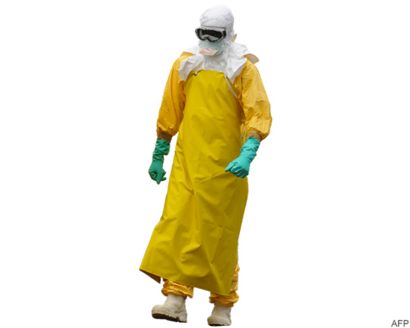Two doctors who treated a Spanish nurse diagnosed with Ebola have been admitted into hospital for observation, health officials say.
The admissions bring to six the total number of people under quarantine at the hospital in Madrid.
A spokesman for the Carlos III hospital said that so far neither of the doctors had shown Ebola symptoms.
Nurse Teresa Romero is the first person to have contracted the deadly virus outside West Africa.
She was part of a team of about 30 staff looking after two missionaries who later died from the virus after being repatriated from West Africa.
Feverish symptomsMs Romero told a Spanish newspaper that she might have become infected when removing her protective suit after cleaning one of the missionaries' room.
Her husband is among those being monitored.
The Ebola outbreak has already killed more than 3,000 people and infected more than 7,200, mostly in West Africa.
The World Health Organization (WHO) describes the disease as a "severe illness" with a 90% death rate.
Spanish newspaper El Pais said that "a chain of human errors" had led to the first contagion of Ebola outside West Africa.
After cleaning the room of one of the missionaries following his death from the virus, Ms Romero took two days off from work and was instructed to monitor her temperature, the paper adds.
Reports as to what happened next vary, but it is believed that several days after cleaning the room she called the hospital reporting feverish symptoms and a temperature of 37.6C.
Sources working at her primary health care centre - where she was referred - told Spanish media that she had not explained that she had been in contact with Ebola-infected patients, and was discharged with painkillers.
The missionaries were Miguel Pajares, 75, who died on 12 August after contracting the virus in Liberia, and Manuel Garcia Viejo, 69, who died on 25 September after catching the disease in Sierra Leone.
Global developmentsIn other developments, the US is introducing new security measures to screen passengers arriving from Ebola-affected countries in West Africa at five major US airports.
In Texas, a county sheriff deputy was quarantined after visiting the home of the first person diagnosed with Ebola on US soil, who later died from the virus.
Thomas Duncan, 42, tested positive in Dallas ten days after returning from his native Liberia.
He became ill a few days after arriving in the US. Even after going to hospital and telling medical staff he had been in Liberia, he was sent home with antibiotics.
Meanwhile, an Australian nurse recently returned from working with the Red Cross in Sierra Leone is undergoing testing in a hospital in Queensland.
She is reported to have had an increased temperature but was "feeling well", the Red Cross said.
Peter Piot, one of the scientists who discovered Ebola in 1976, has told the BBC more must be done to stop the spread of the virus, saying he never imagined an outbreak "could have got to this point".
|
Source: NHS and World Health Organization |
|
People can catch Ebola if they are in direct contact with the bodily fluids of an infected person or animal |
|
Early symptoms include fever, muscle pain, headache and sore throat. This is followed by vomiting, diarrhoea and bleeding, sometimes from the eyes and mouth |
|
The current outbreak started in March in west Africa, where the worst-affected countries include Guinea, Sierra Leone and Liberia |
|
It is thought unlikely that the disease would spread if it did come to the UK because quarantine and communications are more developed than in parts of western Africa |
|
There is no licensed Ebola vaccine but treatments are in development |
INTERACTIVE
- ×

- ×
Goggles, or eye visors, are used to provide cover to the eyes, protecting them from splashes. The goggles are sprayed with an anti-fogging solution before being worn.
- ×
Covers the mouth to protect from sprays of blood or body fluids from patients. When wearing a respirator, the medical worker must tear this outer mask to allow the respirator through.
- ×
A respirator is worn to protect the wearer from a patient's coughs. According to guidelines from the medical charity Medecins Sans Frontieres (MSF), the respirator should be put on second, right after donning the overalls.
- ×
A surgical scrub suit, durable hospital clothing that absorbs liquid and is easily cleaned, is worn as a baselayer underneath the overalls. It is normally tucked into rubber boots to ensure no skin is exposed.
- ×
The overalls are placed on top of the scrubs. These suits are similar to hazardous material (hazmat) suits worn in toxic environments. The team member supervising the process should check that the equipment is not damaged.
- ×
A minimum two sets of gloves are required, placed over the suit sleeves. Medical workers must change gloves between patients, performing thorough hand hygiene before donning a new pair. Heavy duty gloves are used whenever workers need to handle infectious waste.
- ×
A waterproof apron is placed on top of the overalls as a final layer of protective clothing.
- ×
Ebola health workers typically wear rubber boots, with the scrubs tucked into the footwear. If boots are unavailable, workers must wear closed, puncture and fluid-resistant shoes.
- ×
The cap forms part of a protective hood covering the head and neck. It offers medical workers an added layer of protection, ensuring that they cannot touch any part of their face whilst in the treatment centre.
Got questions about Ebola? Our health correspondent Branwen Jeffreys answers them here.
Anda sedang membaca artikel tentang
Spanish doctors monitored for Ebola
Dengan url
http://beritaberbagiceria.blogspot.com/2014/10/spanish-doctors-monitored-for-ebola.html
Anda boleh menyebar luaskannya atau mengcopy paste-nya
Spanish doctors monitored for Ebola
namun jangan lupa untuk meletakkan link
Spanish doctors monitored for Ebola
sebagai sumbernya
0 komentar:
Posting Komentar